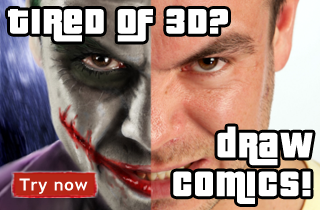“Caustics in MentalRay” by Toni Bratincevic
Why is the surface so white? Because of to bright caustics effect. To decrease the intensity of the caustics select the light and jump to it’s attribute editor (Ctrl+A) then go to the mentalray > caustics and global illumination section. As you already know from the first part of tutorial, we can control the intensity with the exponent and energy values. This time we will experiment with both parameters. For this situation I’v set the energy value to 2000 and exponent value to 3.6. Let’s make one quick test render:

3Dtutorials.sk recommendation:
To maximise the realism of your 3D rendering we recommend to use high quality photo textures from the #1 texture website www.environment-textures.com
Ok, now that we have satisfying intensity level of caustics we will continue to fine tune it to get the better quality of it. The next value with which we will play a little bit is Caustics Photons. I suppose you already know where is it. 😉 Since the surface on which the photons are casted is pretty big, we must increase this value to very high levels. So let’s make a few example images with different caustics photons values…




Caustic Photons 10 000 (Default)
Caustic Photons 30 000
Caustic Photons 60 000
Caustic Photons 100 000
It easier to decide which fits our need when we have few pictures like the ones above. 😉 The rendering of all four pictures is relatively fast so we dont have to worry about that. As for the quality, yes the last one is the best one, but the third is also fine, so we will pick the value between these two. Let there be 80 000 photons. 😉
There are still few values we have to play with to get the better result. They are in Render Globals (mentalray) > mentalrayOptions1 > section Caustics/Global Illumination. Since we have very high Caustic Photons value we will increase the Caustics Accuracy to 100. This will collect more photons when calculating caustics and the effect of this is that the result is a little bit smoother. I also found out that if you set Caustic Filter Type to Cone you’ll get rid of the noise and get much better result than box filter. Let’s show these effects on next pictures:



Caustics Accuracy 64Caustics Filter Type Box
Caustics Accuracy 100Caustics Filter Type Box
Caustics Accuracy 100Caustics Filter Type Cone
We will stick to the values from the last picture… now you can do a test animation if you want. You just need to animate the bump value on the sea surface. 😉
And that’s it. Let’s go to last section…
EXAMPLE 3 – Reflective objects
Now we will just show you one simple example of how caustics can be used with reflective objects. Just load our last scene (scene03a)…
In this scene I already set the light to cast shadow and to emit the caustic photons. I didn’t set the caustics on in mentalrayOption1 … you will do that, just after we do one qick render of the scene:

From the picture above you can see that we have three object in the scene, the sphere the wall and the floor. I’v set the wall and sphere to be reflective object. I suppose you already know how to do that… 😉 Because they are reflective they will reflect the photons emitted from the light source and cast it on to the floor. Let’s turn on caustics: Render View > RenderGlobals (mentalray) > Quality section > click on the box near RenderQuality > then when mentalrayOptions1 opens go to the Caustics/Global Illumination and turn on Caustics. Render again:

As you can see, since the wall has red color and reflective surface, it reflects photons from the light source and illuminates a floor a little bit. This is also happening with the sphere and the floor. The intensity of the caustics is driven by the few parameters of the objects material. These are the color of the object, the specular color and reflectivity. By increasing the specular color and reflectivity you’ll get the brighter caustic effect, and by changing the color of the object you are changing the color of casustics. The picture below is one example of this … I’v changed the specular to be brighter than before and as you can see it emits more red color on the floor.

That’s it. The end of our caustics tutorial. I hope that I helped a little bit with these examples. I know that they are as simple as they can be, but it can be a good start for beginners in proces of learning how to use mentalray for maya.
Happy rendering, and bye till next tutorial. 😉
(c) Toni Bratincevic, http://www.interstation3d.com







Latest Comments